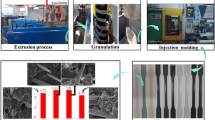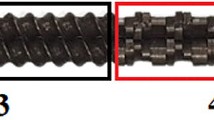Abstract
Complex microstructure of the polypropylene/ poly(ethylene-co-propylene) in-reactor blends has been the subject of many studies. In this work simple two-step polymerization procedure was considered and effects of adding another copolymerization step with low ethylene concentration were investigated. The blends microstructure and morphology as well as mechanical properties were studied. The blends were characterized using dynamic mechanical thermal analysis (DMTA), gel permeation chromatography (GPC), scanning electron microscopy (SEM), differential scanning calorimetry (DSC) and temperature gradient elution fractionation (TGEF). It was found that adding an extra copolymerization step under low ethylene concentration caused considerable increase in the blends toughness, elongation at break and the number of very small dispersed particles in the polypropylene matrix. The mentioned polymerization step produced copolymers having long polypropylene sequences capable to take part in crystallization of polypropylene matrix, suggested acting as linkage between rubber and polypropylene phases. Although the amorphous copolymer related to the additional copolymerization step had a role in decreasing the average size of dispersed phase, the difference in crystallizable copolymer microstructure suggested had a key role in marked enhancement of mechanical properties.














Similar content being viewed by others
References
Ven S (1990) Polypropylene and other polyolefins: polymerization and characterization. Elsevier, Amsterdam
Martuscelli E (1995) Structure and properties of polypropylene-elastomer blends. In: Karger-Kocsis J (ed) Polypropylene structure, blends and composites. Chapman & Hall, London
Liang JZ, Li RKY (2000) Rubber toughening in polypropylene: a review. J Appl Polym Sci 77:409–417
Chiu HT, Shiau YG, Chiu WM, Syau SS (1995) Toughening isotactic polypropylene and propylene-ethylene block copolymer with styrene-ethylene butylene-styrene triblock copolymer. J Polym Res 2:21–29
Yokoyama Y, Ricco T (1998) Toughening of polypropylene by different elastomeric systems. Polymer 39:3675–3681
Soni R, Singh H, Dutt K, Arora P (2010) Effect of dynamic cross-linking on mixing torque behavior and tensile yield behavior of isotactic polypropylene (iPP) / ethylene-propylene diene rubber (EPDM) /nitrile rubber (NBR) elastomeric blends. J Polym Res 17:411–427
Zhu L, Xu X, Sheng J (2011) Study on phase structure and evolution of PP/PEOc blends during heat preservation process under quiescent condition. J Polym Res 18:1269–1275
Galli P, Vecellio G (2001) Technology: driving force behind innovation and growth of polyolefins. Prog Polym Sci 26:1287–1336
Galli P (1994) The breakthrough in catalysis and processes for olefin polymerization: Innovative structures and a strategy in the materials area for the twenty-first century. Prog Polym Sci 19:959–974
McKenna T, Bouzid D, Matsunami S, Sugano T (2003) Evolution of particle morphology during polymerisation of high Impact polypropylene. Polym React Eng 11:177–197
Du J, Niu H, Dong JY, Dong X, Han CC (2008) Self-similar growth of polyolefin alloy particles in a single granule multi- catalyst reactor. Adv Mater 20:2914–2917
Chen Y, Chen Y, Chen W, Yang D (2008) Multilayered core–shell structure of the dispersed phase in high-impact polypropylene. J Appl Polym Sci 108:2379–2385
Zhang C, Shangguan Y, Chen R, Zheng Q (2011) Study on thermal behavior of impact polypropylene copolymer and its fractions. J Appl Polym Sci 119:1560–1566
Cai H, Luo X, Ma D, Wang J, Tan H (1999) Structure and properties of impact copolymer polypropylene. I Chain structure. J Appl Polym Sci 71:93–101
Tong C, Lan Y, Chen Y, Chen Y, Yang D, Yang X (2012) The functions of crystallizable ethylene-propylene copolymers in the formation of multiple phase morphology of high impact polypropylene. J Appl Polym Sci 123:1302–1309
Liu YL, Xu JT, Dong Q, Fu ZS, Fan ZQ (2009) Crystallization behavior of the blends of isotactic polypropylene and ethylene-propylene blocky copolymers. Polym Plast Technol Eng 48:333–341
Zhang C, Shangguan Y, Chen R, Wu Y, Chen F, Zheng Q, Hu G (2010) Morphology, microstructure and compatibility of impact polypropylene copolymer. Polymer 51:4969–4977
Tan H, Li L, Chen Z, Song Y, Zheng Q (2005) Phase morphology and impact toughness of impact polypropylene copolymer. Polymer 46:3522–3527
Rungswang W, Saendee P, Thitisuk B, Pathaweeisariyakul T, Cheevasrirungruang W (2013) Role of crystalline ethylene-propylene copolymer on mechanical properties of impact polypropylene copolymer. J Appl Polym Sci 128:3131–3140
Doshev P, Lohse G, Henning S, Krumova M, Heuvelsland A, Michler G, Radusch HJ (2006) Phase interactions and structure evolution of heterophasic ethylene-propylene copolymers as a function of system composition. J Appl Polym Sci 101:2825–2837
Pires M, Mauler RS, Liberman SA (2004) Structural characterization of reactor blends of polypropylene and ethylene-propylene rubber. J Appl Polym Sci 92:2155–2162
Zhang YQ, Fan ZQ, Feng LX (2002) Influences of copolymerization conditions on the structure and properties of isotactic polypropylene/ethylene–propylene random copolymer in situ blends. J Appl Polym Sci 84:445–453
Fan Y, Zhang C, Xue Y, Nie W, Zhang X, Ji X, Bo S (2009) Effect of copolymerization time on the microstructure and properties of polypropylene/poly (ethylene-co-propylene) in-reactor alloys. Polym J 41:1098–1104
Dong Q, Fu Z, Xu J, Fan Z (2007) Strong influences of cocatalyst on ethylene/propylene copolymerization with a MgCl2/SiO2/TiCl4/diester type Ziegler-Natta catalyst. Eur Polym J 43:3442–3451
Dong Q, Wang X, Fu Z, Xu J, Fan Z (2007) Regulation of morphology and mechanical properties of polypropylene/poly(ethylene-co-propylene) in-reactor alloys by multi-stage sequential polymerization. Polymer 48:5905–5916
Li Y, Xu J, Dong Q, Fu Z, Fan Z (2009) Morphology of polypropylene/poly(ethylene-co-propylene) in-reactor alloys prepared by multi-stage sequential polymerization and two-stage polymerization. Polymer 50:5134–5141
Bagheri H, Nekoomanesh M, Hakim S, Jahani Y, Fan ZQ (2011) Structural parameters in relation to the rheological behavior and properties of PP/EPR in-reactor alloy synthesized by multi-stage sequential polymerization. J Appl Polym Sci 121:3332–3339
Tian Z, Gu XP, Wu GL, Feng LF, Fan ZQ, Hu G-H (2011) Periodic switching of monomer additions for controlling the compositions and microstructures of segmented and random ethylene-propylene copolymers in polypropylene in-reactor alloys. Ind Eng Chem Res 50:5992–5999
Kittilsen P, McKenna TF (2001) Study of the kinetics, mass transfer, and particle morphology in the production of high-impact polypropylene. J Appl Polym Sci 82:1047–1060
Shin YW, Uozumi T, Terano M, Nitta KH (2001) Synthesis and characterization of ethylene-propylene random copolymers with isotactic propylene sequence. Polymer 42:9611–9615
Author information
Authors and Affiliations
Corresponding author
Electronic supplementary material
Below is the link to the electronic supplementary material.
ESM 1
(TIF 22.6 MB)
Rights and permissions
About this article
Cite this article
Moballegh, L., Hakim, S., Morshedian, J. et al. A new approach to increase toughness of synthesized PP/EPR in-reactor blends by introducing a copolymerization step under low ethylene concentration. J Polym Res 22, 73 (2015). https://doi.org/10.1007/s10965-015-0709-3
Received:
Accepted:
Published:
DOI: https://doi.org/10.1007/s10965-015-0709-3




